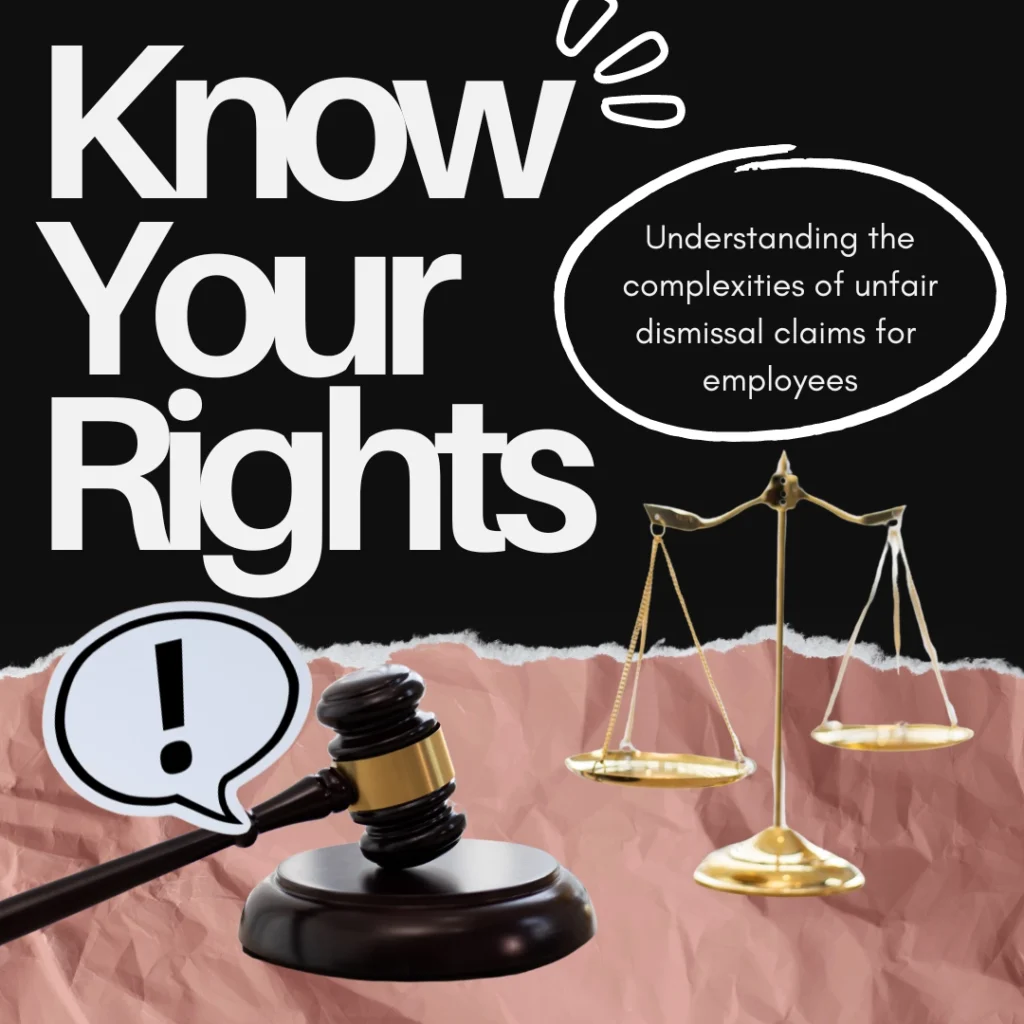Navigating the complex landscape of workplace rights in Australia can be daunting. Unfair dismissal is a topic that often comes to the fore, provoking anxiety and confusion among both employers and employees.
So, let’s break it down.
In our last blog we looked at navigating unfair dismissal laws from the perspective of an employer, now we turn to consider the other side: navigating unfair dismissals as an employee.
What is Unfair Dismissal?
Simply put, unfair dismissal happens when an employee is let go from their job in a way that’s considered unfair.
Under the Fair Work Act 2009 (Cth) (Fair Work Act), it’s considered unfair if an employer terminates an employee in a way that is harsh, unjust or unreasonable, lacks a valid reason connected to the employee’s performance or conduct, or is not procedurally fair.
An individual will be protected from unfair dismissal if they have:
- completed the minimum period of employment; and
- six months; or
- one year, where the employer is defined as a Small Business.
- earn less than the high-income threshold or fall under a modern award/enterprise agreement concerning their employment (as of July 2024, the high-income threshold is: $175,000)
Why does it exist? Unfair dismissal protections are designed to protect employees from wrongful termination, but they also help provide employers with a clear framework for lawful employee dismissal.
Employment Status:
When determining eligibility for making an unfair dismissal claim, your employment status plays a crucial role.
Contractor – contractors generally aren’t covered by unfair dismissal protections, because they are not considered employees. However, there are sometimes situations where you may be working on an independent contract basis BUT are undertaking work or have a relationship with the employer which suggests they are actually an employee. In these cases, you might be eligible to make an unfair dismissal claim.
Casual – if you’re a casual employee, you’ll have to prove that there was a continuous period of regular and systemic employment and that there was no intention of the employment relationship ending in the relevant period.
In addition to showing regular and systematic employment, the casual employees must also have been employed for at least six months, or twelve months if they were employed by a small business (defined as an employer with fewer than 15 employees).
Not all unfair dismissals involve a direct dismissal either….
Were you fired or forced to step down?
Forced resignation, sometimes referred to as ‘constructive dismissal’ occurs when the employee has no real choice but to resign. The employee will need to prove that they did not resign voluntarily and rather were forced by the employer. The FWC will carefully consider whether there was no real choice to resign or if a decision was made on the employee’s own initiative.
Not fired but demoted?
If an employee is demoted and this demotion involved a significant reduction in duties or remuneration, it may still be considered a ‘dismissal’ even where the employee remains employed in that demoted position.
I Think I’ve Been Unfairly Dismissed…
If you think you’ve been unfairly dismissed, it’s important to act quickly. You typically have just 21 days after being let go to file an unfair dismissal claim with the Fair Work Commission. As an employee, the key to effectively challenging a dismissal lies in knowing your rights and being familiar with the correct procedures. Seeking the advice of an experienced employment lawyer or consultant can provide immense strategic guidance and advocacy, ensuring that your case is presented in the best light and to your advantage.
Here’s an example hypothetical scenario that highlights where unfair dismissal claims can get tricky for individuals:
You’re an employee whose workload has suddenly doubled. Despite your best efforts, keeping up feels impossible. Your manager hints that you might be happier at another company but hasn’t formally addressed any performance issues. Feeling pressured and unsupported, you resign from your position.
After stepping down, you think about claiming unfair dismissal under the grounds of constructive dismissal, arguing that your employer’s actions and then unreasonable increase in workload effectively forced you out.
Here’s where it gets complicated: Constructive dismissal cases hinge on proving that an employer’s conduct effectively made continued employment unbearable, pushing you to resign. This situation demands that you show that the employer’s actions (or lack thereof), including the subtle nudge towards resignation and the sudden spike in workload, were both unfair and unreasonable. So when making a claim, here are some of the questions you’ll have to consider:
- What proof do you have that your workload was unreasonably increased
- Did you document any formal complaints to your employer about the workload or work conditions?
- How did your employer respond to your complaints or concerns about the increased workload?
- Does your employment contract specify your job duties and workload limits?
- How did your manager suggest you might be happier elsewhere, and was it presented as a threat?
- How does your workload compare to normal industry standards for your role?
- Did you attempt any internal resolutions, such as discussing issues with HR?
- How did the conditions affect your health and well-being?
- Can you demonstrate that resignation was your only reasonable option due to intolerable conditions?
- How long after the changes did you resign, and does the timing support your claim?
This scenario underscores that the difficulty for employees navigating a potential constructive dismissal claim lies primarily in proving that the employer’s actions were son unreasonable that resignation was the only viable option. Each case depends heavily on the specifics of the situation and the ability to clearly demonstrate unfair treatment under the law.
What Makes Unfair Dismissals So Complicated?
Unfair dismissals are inherently complex due to the multitude of factors involved in each case. Figuring out if a dismissal is unfair involves looking at the reasonableness of the dismissal reason, the processes the employer followed, and whether the employee was given a chance to mend their conduct or performance. Additionally, both parties must wade through the detailed legal frameworks and procedural timelines of the Fair Work Commission, which can be overwhelming and resource-intensive.
For a real case study, check out our summary of Tomaso Edwards Moro v Insider Au Pty Ltd [2023], in the first part of our UD series here.
We Can Support You
Dealing with unfair dismissals and adverse action claims can be both time-consuming and technical. For employees, partnering with specialised advocates who manage the legal complexities and advocate for your rights means you can stay focused on your personal and professional life. Having a knowledgeable advocate on your side can also help ensure that your rights are defended and it can increase your chances of achieving a favourable outcome.
If you find yourself facing an unfair dismissal claim, it’s crucial to seek professional assistance. Opting for specialised support that prioritises your interests and navigates you through the legal intricacies can not only significantly impact the outcome of your case, but it can also give you piece of mind.
Our employment consultants at Workplace Wizards can assist in assessing your employment case and determining the appropriate unfair dismissal remedy for you.
We can assist you if you need to defend a claim of unfair dismissal and provide you with comprehensive legal support throughout the process.




Comments are closed.